Pandemic Impact on Youth Employment
The initial wave of COVID layoffs between March 15th and April 25th, 2020, severely impacted younger Seattle area workers. They accounted for a large share of unemployment claimants and were more likely to have been laid off as they filed for unemployment at a higher rate than older workers. Overall, they were approximately twice as likely to experience unemployment than older workers (31% unemployment rate for the 18- to 24-year-old vs 15% for the 25+-year-old)1.

Figure 1. Initial unemployment insurance claims and labor force by age, March-April 2020, Seattle-Tacoma-Bellevue MSA.
Declining Youth Unemployment Rates
Despite the large initial increase in youth unemployment, recent data shows that the share of the 16-to-24-year-old among continuous UI claims declined from 12% in April 2020 to 4.6% in October 2021 (latest estimates available). Similarly, the unemployment rate of younger workers has declined to 13% in September 2021 (though still much higher than the 4% unemployment rate for workers aged 25+).

Figure 2. Continued unemployment insurance claims by age, April 2020, and September 2021, Seattle-Tacoma-Bellevue MSA.
The declining youth unemployment rate could be due to several reasons, such as an increase in employment among this demographic group or a decline in labor force participation rate (as the youth exit the labor market out of discouragement or to enroll in college, for example). However, the participation rate of young adults aged 16-24-year-old is relatively constant between April 2020 (59%) and September 2021 (56%), while employment rates increased from 69% to 87% in the same period. These trends show that the increase in youth employment is driving the unemployment rate decline.

Figure 3. Unemployment rate by age group, Seattle-Tacoma-Bellevue MSA.
Declining Youth Post-Secondary Enrollments
Preliminary data shows that the pandemic negatively impacted enrollment and retention rates at public colleges. Headcount of those aged 24-year-old or younger at colleges serving the Seattle-MSA area (King, Pierce, and Snohomish)2 decreased by 13% between the 2019-2020 and 2020-2021 academic years. This decline reached 21% for the Seattle community colleges, representing an annual loss of 3,240 students. Additional data for 2021 is needed to understand whether this decline is permanent.

Figure 4. Annual enrollments (headcount) for the Seattle Colleges (Central, North, and South Seattle College).
Retention rates3 at select colleges have also declined between fall quarter 2019 and fall quarter 2020, particularly for part-time students (-8% compared to -6% for full-time students). While data is still unavailable for the Seattle Colleges, these institutions have a significant historical discrepancy between full-time (70%) and part-time (30%) students retention rates4. Future data releases will reveal whether the pandemic further aggravated this difference. The Education Advisory Board estimated that part-time students nationwide are more likely to come from underserved communities: 52% are low income and first-generation students (52%), and 64% of Hispanic and 59% of Black and African American students enroll part-time5.
Slow Labor Market Recovery
Even though the youth unemployment rate declined since the beginning of the pandemic (31% in April 2020 vs 13% in September 20216), it is still 11 percentage points higher than the pre-Covid level (2% in December 2019). There are multiple factors to explain this slow recovery.
First, younger people are more likely to work in industries that suffered most from business closures, such as retail trade and hospitality. For example, 18% of workers aged 24-year-old or below in the Seattle-MSA are currently employed in “Accommodation & Food Services” which experienced one of the most substantial declines (-47%) in entry-level job postings during the pandemic7. Despite strong growth in 2021 (+27%), the sector’s entry-level job postings are still below their pre-pandemic levels by 897 postings.
Similarly, labor demand from “Retail Trade” and “Healthcare and Social Assistance” sectors which provide a livelihood to many young workers abruptly declined during the pandemic. Recovery is ongoing (+10% and +16% respectively between 2020 and 2021), but demand for entry-level workers in these sectors are also still below their pre-pandemic levels (-1,084 and -3,050 fewer job postings, respectively). This slow recovery helps explain why the unemployment rate is still relatively high for younger workers.
Other factors barring the youth from full employment include:
- Digital equity gap precludes opportunities to enroll in online learning but also creates barriers to applying for and interviewing for jobs.
- Housing instability creates barriers to retaining employment when individuals must relocate away from workplaces or lack a fixed residence.
- Increased family responsibilities such as providing childcare for younger family members during the pandemic.

Figure 5. Labor demand recovery in industries employing younger workers, Seattle-Tacoma-Bellevue, MSA
[1] Current Population Survey, 2020 and 2021, U.S. Census Bureau.
[2] Colleges included in this report: Bates, Bellevue, Cascadia, Clover Park, Edmonds, Everett, Green River, Highline, Lake Washington, Pierce, Renton, Seattle Central, North Seattle, South Seattle, Shoreline, Tacoma.
[3] Retention rates for fall quarter 2020 are currently only available for the following three colleges: Bates, Everett, and Shoreline. Source: IPEDS.
[4] Seattle Colleges District Board of Trustees, May 2021.
[5] EAB, “Reframing the Question of Equity: Understanding the Growing Importance of Success for Community Colleges’ Part-Time Students”, 2018.
[6] Current Population Survey, 2020 and 2021, U.S. Census Bureau.
[7] Unique job postings between January and August 2019 and January and August 2021 for entry-level positions (requiring 0 to 3 years of work experience, and an Associate degree at most). Source: Emsi-Burning Glass.

Recent Comments